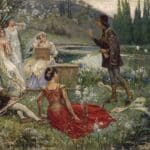Talk is a halfway house between thinking and writing: how can teaching with pictures remove barriers to oral composition?
The ease and speed of instantly being able to find images and photographs to support teaching and learning is astonishing. Pictures are powerful teaching tools, and a great asset for teachers wanting to maximise the classroom impact of strong, inclusive and adaptive teaching approaches grounded in research.
Chatta is a simple whole class teaching approach based on audio-visual scaffolding, whilst seamlessly combining numerous effective features of cognitive science. An example of a Chatta activity in year 4 at Lyons Hall Primary School can be viewed here:
In the video, the teacher builds the board with the class step by step, speaking in the style of the expected outcome. The pupils have numerous opportunities to speak, composing and adapting their own sentences and listening to others. The images help pupils make the move from thoughts into words.
How Chatta Works
Teachers create an audio-visual storyboard with the class, as they explain content for any purpose, in any style, speaking using the phrasing and vocabulary of the genre or expected outcome. There are lots of opportunities for fast-paced partner work and pupils can come to the front to present orally to the class, with the storyboard providing simple cues.

The storyboard acts as a schema related both to content coverage coupled with the style and structure of the language used to present/explain the information it conveys.
Teacher Feedback
Class teacher, Lauren Williams saw the impact Chatta made for the class. ‘The entire class explored language collectively, fostering improvement in sentences through whole class, paired, and individual activities. Students, regardless of their challenges eagerly participated. Notably, a shy boy with ASD surprised everyone by confidently showcasing new-found adventurous language skills. This positive experience extended beyond the lesson, as he now actively engages in debates and discussions. The emphasis on verbal expression translated to confident independent writing, demonstrating focused application of high-quality language. Weeks later, students continue to reference and apply persuasive vocabulary learned during the session.’
Teacher subject knowledge is central, as is the skill in modelling sentence composition in any style and for any purpose. The synergy between images and language can create a potent blend that can transform outcomes. A learning environment where teaching builds on a captivating interplay between images and language, offers simple, powerful opportunities with endless possibilities.
Teaching with pictures is a powerful to harness the impact and insights offered by aspects of cognitive science, and benefits for all learners can be huge, especially for those with challenges related to working memory, sequencing and processing.
“People can learn more deeply from words and pictures than from words alone.” (1)
The use of images and spoken words builds on key aspects of The Cognitive Theory of Multimedia Learning in that presenting images and spoken words is more effective than presenting text and spoken words (PEN Principles Science of Learning and Research Centre) (2). The sequential adding of content, broken up into manageable chunks prevents cognitive overload, as does the use of picture cues.

Vygotsky’s ‘Socio-Cultural Theory’ (3) places great emphasis on the value of expert models of spoken language and the importance of interaction in building language skills and understanding. Thoughts become words, words become speech, speech can become writing.
Talk is a halfway house between thinking and writing and the use of the Chatta storyboards can support effortless oral composition opportunities for all pupils, helping to build skills which can strengthen vocabulary use, remove barriers to writing and build subject knowledge.

Oral composition activities with Chatta can be quick. Once pupils have been able to orally compose their outcomes teachers can focus on moving forward with the technical aspects of writing. Pupils will know what to write and be raring to go. Spending a little time on fluent and fluid oral work can help eliminate the dread offered by a blank page and the struggling writer’s mantra ‘I don’t know what to write.’

References:
1: Mayer RE, ed. (2014) In: The Cambridge Handbook of Multimedia Learning. Cambridge Handbooks in Psychology. Cambridge University Press.
2: Science of Learning Research Centre, PEN Principles https://www.slrc.org.au/resources/pen-principles/
3: Vygotsky, L. S. (1978). Mind in society: The development of higher psychological processes. Cambridge, MA: Harvard University Press.



